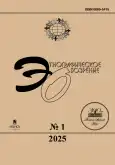Cinema-Atlas of the USSR: “In Bryansk Polesie” [Kinoatlas SSSR: “V Brianskom Poles’ie”].
- Authors: Golovnev I.A.1
-
Affiliations:
- Peter the Great Museum of Anthropology and Ethnography (the Kunstkamera), Russian Academy of Sciences
- Issue: No 1 (2025)
- Pages: 64-86
- Section: Visual anthropology
- URL: https://journal-vniispk.ru/0869-5415/article/view/287794
- DOI: https://doi.org/10.31857/S0869541525010044
- EDN: https://elibrary.ru/URQOCH
- ID: 287794
Cite item
Abstract
In the 1920s and 1930s, the scientific and creative community of the young Soviet state was involved in the implementation of the state program “Cinema-Atlas of the USSR”, which implied the accumulation of potential of research institutes and film studios for the production of a documentary film series about the peoples and regions of the diverse, multinational Soviet Union. One of the expressive examples of the parity of ethnography and cinematography in this context was the film “In Bryansk Polesie” (1931). Its creators were, on the one hand, experienced filmmakers, employees of the largest in the country “Soyuzkino” factory, director I.P. Kopalin and cameraman P.P. Zotov, and on the other hand – the famous researcher of the culture of the Eastern Slavs N.I. Lebedeva, representing the interests of the Central Museum of Ethnology. The general architecture of the considered film narrative is a typical example of an early Soviet ethnofilm: the transition of local communities from the “dark past” to the “bright future” is filmed. The article presents the results of the research experience of separating the “Soviet” layer from the “ethnographic” layer in this film document with a focus on its substantive and methodological aspects. It is shown that the film “In Bryansk Polesie” has a multifaceted scientific potential, since it is a multi-layered source for studying both the cultural traditions of the Polesie population and the history of the socialist reconstruction of the region.
Full Text
About the authors
Ivan A. Golovnev
Peter the Great Museum of Anthropology and Ethnography (the Kunstkamera), Russian Academy of Sciences
Author for correspondence.
Email: golovnev.ivan@gmail.com
ORCID iD: 0000-0003-4866-7122
д. и. н., ведущий научный сотрудник
Russian Federation, Saint PetersburgReferences
- Arziutov, D.V. 2016. Etnograf s kinokameroi v rukakh: Prokof’evy i nachalo vizual’noi antropologii samodiitsev [Ethnographer with a Movie Camera in His Hands: The Prokofievs and the Beginning of Visual Anthropology of Samoyeds]. Antropologicheskii forum 29: 187–219.
- Grinkova, N. 1928. Review of Narodnyi byt v verkhov’iakh Desny i v verkhov’iakh Oki (Etnologicheskaia ekspeditsiia v Brianskoi i Kaluzhskoi guberniiakh v 1925-om i 1926-om godakh) [Folk Life in the Upper Reaches of the Desna and in the Upper Reaches of the Oka (Ethnological Expedition in the Bryansk and Kaluga Provinces in 1925 and 1926)]. Pt. 1, Priadenie i tkachestvo [Spinning and Weaving], by N.I. Lebedeva. Etnografiia 1: 144–145.
- Golovnev, I.A. 2021. Vizualizatsiia etnichnosti v sovetskom kino (opyty uchenykh i kinematografistov 1920–1930-kh gg.) [Visualization of Ethnicity in Soviet Cinema (Experiences of Scientists and Cinematographers of the 1920s–1930s)]. St. Petersburg: MAE RAN.
- Golovnev, I.A. 2022. Kino i etnografiia: kontseptsiia Nikolaia Yakovleva [Cinemato-graphy and Ethnography: The Concept of Nikolai Yakovlev]. Etnograficheskoe obozrenie 1: 213–230. https://doi.org/10.31857/S0869541522010134
- Golovneva, E.V., and I.A. Golovnev. 2021. Sovetskaia antireligioznaia fil’ma. “Sektanty” Vladimira Korolevicha (1930) [Soviet Anti-Religious Film: “Sectarians” by Vladimir Korolevich (1930)]. Religiovedenie 3: 151–159. https://doi.org/10.22250/2072-8662.2021.3.151-159
- Danilko, E.S. 2022. Ural’skie staroobriadtsy v sovetskih kinomaterialah [Ural Old Believers in Soviet Film Footage]. Sibirskie istoricheskie issledovaniia – Siberian Historical Research 4: 91–122. https://doi.org/10.17223/2312461X/38/6
- Iliinskaia, I. 1930. Tsentral’nyi muzei narodovedeniia [Central Museum of Ethnology]. Etnografiia 9–10: 146–148.
- Korobkov, N. 1933. Kinoatlas SSSR [Cinema-Atlas of the USSR]. Sovetskoe kraevedenie 2: 15–20.
- Lebedeva, N.I. 1927. Narodnyi byt v verkhov’iakh Desny i v verkhov’iakh Oki (Etnologicheskaia ekspeditsiia v Brianskoi i Kaluzhskoi guberniiakh v 1925-om i 1926-om godakh) [Folk Life in the Upper Reaches of the Desna and in the Upper Reaches of the Oka (Ethnological Expedition in the Bryansk and Kaluga Provinces in 1925 and 1926)]. Pt. 1, Priadenie i tkachestvo [Spinning and Weaving]. Smolensk: Gostipografiia imeni Smirnova.
- Lebedeva, N.I. 1929. Ocherednye voprosy izucheniia priadeniia i tkachestva [Current Issues in the Study of Spinning and Weaving]. Moscow: Izdanie Moskovskogo kabineta kraevedeniia.
- Lebedeva, N.I. 1997. Etnologicheskie materialy [Ethnographic Materials]. Riazan’: Riazanskii oblastnoi tsentr narodnogo tvorchestva.
- Magidov, V.M. 2008. Kinoatlas SSSR: Istoriia sozdaniia serii fil’mov po vizual’noi antropologii [The History of the Visual Anthropology Film Series]. In Audiovizual’naia antropologiia. Istoriia s prodolzheniem [Audiovisual Anthropology: A Story to Continue], 136–141. Moscow: Institut Naslediia.
- Martin, T. 2011. Imperiia “polozhitel’noi deiatel’nosti”. Natsii i natsionalizm v SSSR, 1923–1939 [Empire of “Positive Activity”: Nation and Nationalism in the USSR, 1923–1939]. Moscow: Rossiiskaia politicheskaia entsiklopediia.
- Polishchuk, N.S. 1999. Podvizhnicheskii put’ v nauke: Nataliia Ivanovna Lebedeva [Ascetic Path in Science: Natalia Ivanovna Lebedeva]. In Repressirovannye etnografy [Repressed ethnographers], edited by D.D. Tumarkin, 1: 265–283. Moscow: Vostochnaia literatura.
- Remishevskii, K.I. 2014. Istoriia, ozhivshaia v kadre: belorusskaia kinoletopis’ [History Brought to Life in the Frame: Belarusian Film Chronicle]. Vol. 1, 1927–1953 [1927–1953]. Minsk: Vysheishaia shkola.
Supplementary files














